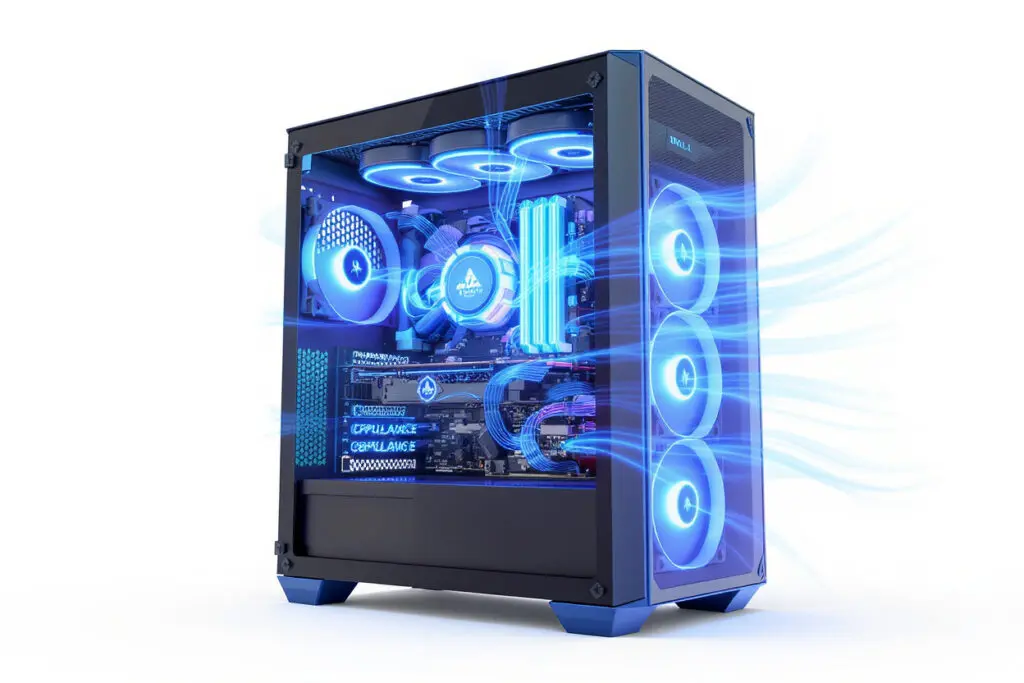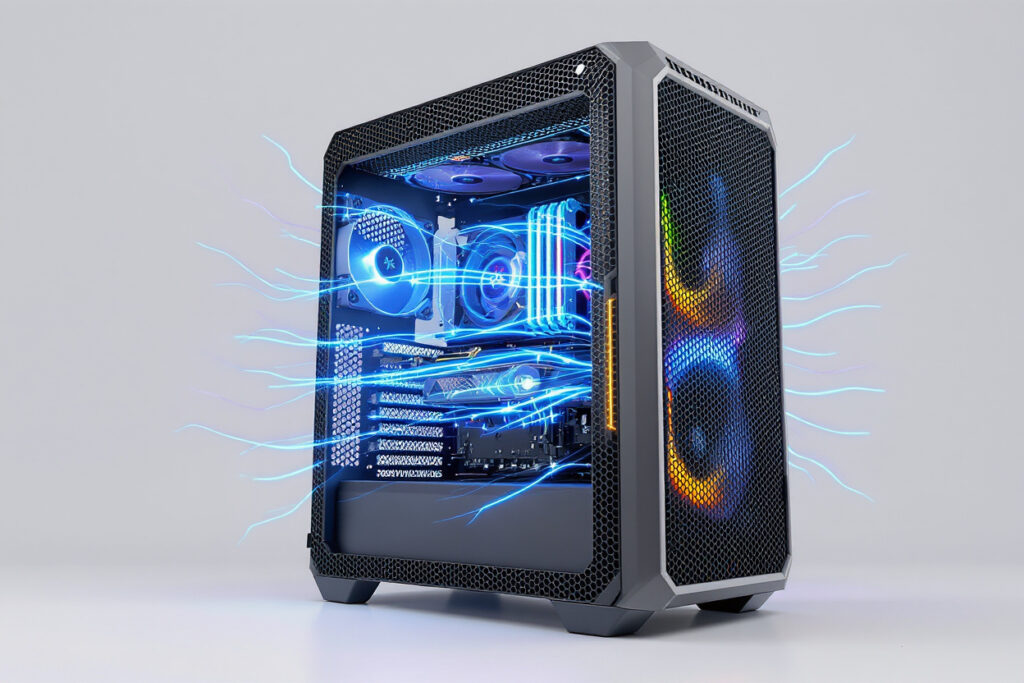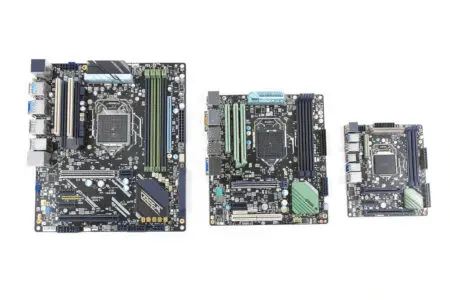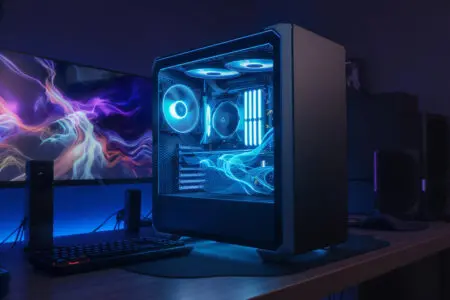Let’s be honest, picking PC parts is the best part. You agonize for weeks over the right CPU, you hunt down a GPU that feels like a mythical beast, and you grab RAM that’s faster than a speeding bullet. Then comes the case. For so many people, it’s just a box. The last thing on the list.
A total afterthought. That’s a critical error. I can still feel the frustration from my first build. I’d poured all my money into the internals, then grabbed a cheap, sealed-off case. Mid-game, everything would grind to a halt. I’d built myself a high-end oven. That costly mistake burned a lesson into my brain: the case isn’t just a shell; it’s your PC’s respiratory system. Which brings us to the big question: what is the best PC case for airflow?
Get this wrong, and nothing else matters. All that powerful hardware will choke. Your components will overheat, they’ll throttle their own performance to survive, and you’ll shorten their lifespan. It’s like forcing a world-class sprinter to run a race breathing through a coffee straw. It just won’t work. This guide is born from years in the trenches—building, testing, and learning from my own blunders. We’re about to break down what truly makes a case great for cooling and show you some of the champs on the market right now.
More in Hardware Category
What is the best CPU cooler for gaming
How to Apply Thermal Paste to a CPU
Key Takeaways
- Go for Mesh: When air cooling is the goal, a mesh front panel beats a solid one, hands down. It’s the difference between breathing freely and trying to inhale through a wall.
- Size Up Your Fans: Bigger 140mm fans push plenty of air without having to spin like crazy. The result? A system that cools effectively without sounding like a jet engine.
- Tidy Cables, Cooler Temps: That rat’s nest of cables isn’t just an eyesore. It’s a wall blocking cool air. Good cable management is a must for a healthy airflow path.
- Placement Over Quantity: Don’t just stuff your case with fans. Where you put them is way more important for creating a smart cooling channel.
- Fight Dust with Positive Pressure: A simple trick: have a bit more air flowing in than out. This positive pressure helps keep dust from sneaking into every crevice of your case.
So, Why Does PC Case Airflow Actually Matter So Much?
You paid for every bit of performance in your CPU and GPU. You should get to use it, right? Well, that power is chained directly to temperature. Your components are smart, but they’re also delicate. When they get too hot, they protect themselves by slamming on the brakes—slashing speed and power. That’s thermal throttling, and it’s the ghost in the machine that steals the performance you paid for.
You can have the most beastly graphics card on the planet, but if it’s trapped in a case that can’t breathe, it’ll cook itself and slow to a crawl. Your export times will stretch into eternity. Your entire experience sours.
I saw this firsthand. I finally ditched an old, sleek-looking case that was basically a sauna for a modern mesh-fronted alternative. The change was immediate and dramatic. My GPU’s gaming temperatures fell by a jaw-dropping 15 degrees Celsius. In an instant, my rig went from a frantic whir to a quiet hum. It was faster and quieter. That’s the power of good airflow. And it’s not just about speed; running your hardware hot all the time is a sure way to kill it early. Heat is the enemy of electronics. A cool PC is a happy PC, and it’ll stick around a lot longer.
What Should I Be Looking For in a High-Airflow Case?
When you’re case shopping, it’s easy to get blinded by the light—the RGB light, that is. Glass panels and flashy designs are cool, but if they come at the expense of airflow, you’re making a bad trade. You have to look for the fundamentals of good thermal design. The best cases all nail these core principles.
Is a Mesh Front Panel Really a Non-Negotiable?
If you’re cooling with air, then yes. It’s that simple. A mesh front panel is essentially a giant doorway for cool air. It gives your intake fans unrestricted access to the air in your room, letting them do their job easily and quietly.
Now, compare that to a solid front panel made of glass or plastic. These cases often look slick, but they force fans to gasp for air through tiny vents on the sides. The fans have to spin harder, make more noise, and they still pull in less air. It’s an inefficient, noisy compromise. While a few premium solid-panel cases have some slick engineering to make it work, a straightforward mesh front is almost always the more effective choice. Plus, they always have easy-to-clean dust filters, which is a huge bonus.
How Many Fans Do I Genuinely Need?
People often think more is better. Just cram fans into every available slot, right? Wrong. The number of fans is less important than the path the air takes. For almost every build out there, a simple, proven setup is all you need to get fantastic results.
Here’s the winning formula:
- Two or three intake fans at the front. Their job is to pull in cool air and wash it over your motherboard, RAM, and especially your hungry graphics card.
- One exhaust fan at the back. This is positioned to quickly pull hot air from your CPU cooler and eject it from the case.
That’s it. That’s the core of a great cooling setup. You can add more exhaust fans to the top to help vent rising heat, but the front-to-back channel is what does the heavy lifting. The best part? Many of the top airflow cases already come with this exact setup included.
Does Fan Size (120mm vs. 140mm) Make a Difference?
It makes a huge difference, mostly for your ears. A larger fan blade can move more air with every single rotation. This means a 140mm fan can spin slower than a 120mm fan while providing the exact same cooling power.
Slower fans mean less noise. It’s that simple. That whirring sound from a PC is the motor and the air being chopped by fast-spinning blades. By using larger fans, you can get amazing cooling without the annoying soundtrack. I personally choose 140mm fans anytime a case supports them. The peace and quiet are worth it. Just make sure to check the case specs to see what sizes fit where before you buy.
Can Bad Cable Management Actually Ruin My Airflow?
Oh, absolutely. It’s a classic rookie mistake. A friend of mine built a killer PC but was getting terrible temps. He asked me to look, and the second I opened the side panel, I saw it. It was a war zone. A giant blob of cables was shoved right behind the intake fans, effectively creating a wall.
We took an hour, unplugged it all, and routed everything properly behind the motherboard tray. Just by cleaning up, his CPU temperatures dropped over 5 degrees. It was a perfect lesson: cable management isn’t just for showing off your build. A clean interior gives air a clear, unobstructed highway to travel from your intakes, over your hot components, and out your exhaust. When you’re looking at a case, check for features like a PSU shroud, routing channels, and plenty of tie-down points. They make your life so much easier.
Let’s Talk Top Picks: Which Cases Actually Deliver?
Alright, theory is great, but let’s look at the hardware. I’ve picked out a handful of cases that are champions of airflow. These are the ones the community respects and that I’ve found to deliver incredible performance, build quality, and value.
Why Is Everyone Talking About the Lian Li Lancool 216?
Because it’s just that good. If you want a case that perfectly balances raw performance, smart features, and a fair price, the Lian Li Lancool 216 is a top contender. It is the poster child for good airflow design. The front is all mesh, feeding two huge 160mm intake fans. It also ships with a 140mm fan for the rear exhaust. That’s a killer cooling configuration straight out of the box.
But the Lancool 216’s real magic is in the details. It’s a dream to build in, with loads of room and clever cable management options. It can handle the biggest GPUs and CPU coolers without breaking a sweat. Lian Li even added a slick rotatable bracket at the back that lets you optimize the rear fan position for either a liquid cooler or a big air tower. It’s smart, practical, and an amazing value. I recommend this case to everyone, from first-timers to grizzled veterans.
- Pros:
- Top-tier cooling performance right away.
- Fantastic stock fan setup (2x 160mm, 1x 140mm).
- Super spacious and easy to work with.
- Genuinely useful design touches.
- Incredible bang for your buck.
- Cons:
- Its looks are more functional than flashy.
- It’s a big boy, so measure your desk.
Can I Get Great Airflow Without Breaking the Bank?
You bet. Cooling your PC well shouldn’t require a second mortgage. For anyone building on a sensible budget, the Phanteks Eclipse G360A is an absolute gem. Phanteks nailed the fundamentals here. You get the all-important mesh front panel and, the real kicker, three 120mm ARGB fans are included and pre-installed as intakes.
Getting three fans at this price is a massive win. It sets you up with a great cooling configuration from the get-go. The build quality is strong, it has a nice glass side panel to show off your work, and there’s enough room to make cable management painless. It might lack some of the bells and whistles of pricier cases, but for what matters most—airflow—the G360A is a phenomenal performer for the money.
- Pros:
- Unbeatable value.
- Includes three ARGB intake fans.
- Awesome airflow from the mesh front.
- Sharp, modern look.
- Cons:
- You’ll need to add your own rear exhaust fan.
- The materials don’t feel quite as premium as the competition.
What If I Want the Absolute Best and Have the Space?
If you’re the kind of person who wants zero compromises and has the desk space to prove it, meet the Fractal Design Torrent. This case is an airflow-obsessed masterpiece. Fractal completely rethought the traditional case layout to optimize it for one purpose: moving massive amounts of air. They moved the power supply to the top of the case, freeing up the entire floor.
The reason for this radical redesign? To fit two gargantuan 180mm fans up front. These custom fans are practically turbines, pushing a colossal volume of air quietly and effectively. The wide-open interior means that air has a direct, uninterrupted shot at your motherboard and GPU. The end result is what many consider the best stock air-cooling performance you can buy, period. It costs a pretty penny, but if you’re cooling a furnace of high-end hardware, the Torrent is in a league of its own.
- Pros:
- Arguably the king of air-cooling performance.
- Brilliant open-layout design is incredibly effective.
- Massive 180mm fans provide quiet, powerful airflow.
- Exceptional build quality and a unique look.
- Cons:
- It’s very expensive.
- The top-mounted PSU can be a little awkward for cable routing.
- This case is seriously large and heavy.
I Have Limited Desk Space, Do I Have to Settle for a Hot Box?
No way. The small form factor (SFF) world has come a long way. My go-to recommendation here is the Cooler Master MasterBox NR200P. This little case is an engineering triumph. It’s tiny, but it’s also a thermal powerhouse thanks to its incredible versatility.
It has ventilated panels everywhere, letting you get creative with your airflow. You can fit fans on the top, bottom, and side, allowing you to directly cool even the most power-hungry components. I built a compact living room gaming PC in an NR200P, and I was blown away. With a couple of fans on the bottom feeding the GPU and two more on top as exhaust, the temps were on par with my full-sized tower. It’s a bit of a puzzle to build in compared to a big case, but the final product is a tiny, cool, and quiet beast.
- Pros:
- Incredible cooling for such a small package.
- Super flexible layout for different builds.
- Solid build quality with tool-free panels.
- Includes both a glass and a vented steel side panel.
- Cons:
- SFF building requires careful planning and nimble fingers.
- Component compatibility is limited (SFX PSU, specific cooler heights).
Beyond the Case: What Else Influences Your PC’s Temperature?
A great case is step one, but a couple of other things can make a real difference in your final temps. Keeping these in mind will help you build the coolest rig possible.
Does My Room Temperature Play a Role?
It plays a huge role. Your PC cools itself by pulling in the air from your room. That room temperature is the starting point, the absolute lowest your components can ever be. If the air going in is already warm, your components will always run hotter. As the basic laws of heat transfer dictate, cooling is more effective when the difference in temperature is greater. A PC in a cool 20°C (68°F) room will always run cooler than the same PC in a stuffy 30°C (86°F) room.
What About Positive vs. Negative Air Pressure?
This sounds technical, but it’s a really simple idea about balancing your fans.
- Positive Pressure: You’ve got more air blowing in than blowing out. This pressurizes the case slightly, and air leaks out of all the little unfiltered gaps. The huge benefit here is that it helps keep dust out of your system.
- Negative Pressure: You’ve got more air blowing out than blowing in. This creates a small vacuum effect, sucking air and dust in through every available opening.
For most people, a slight positive pressure is the way to go. You get great cooling performance and a much cleaner PC. It’s why a setup with two or three intakes and one exhaust is such a sweet spot.
So, What’s the Final Verdict on the Best PC Case for Airflow?
There’s no single “best” case for every builder. Your budget, your parts, and your personal style all play a part. But the rules for great airflow don’t change. You need a case that makes it easy for cool air to get in and hot air to get out. That means a mesh front, a smart layout, and a decent set of fans creating a clear airflow path.
Any of the cases on this list will give you a fantastic foundation for a cool, quiet, and powerful PC. They represent the best of the best, from budget heroes to cost-no-object champions. After all these years, there’s still nothing more satisfying than finishing a build, running a stress test, and seeing low, stable temperatures. It’s the sign of a job well done and a PC that’s ready for anything.
FAQ – What Is the Best PC Case for Airflow

Can poor cable management affect my PC’s airflow?
Absolutely. Poor cable management can obstruct airflow paths, trapping hot air and increasing component temperatures, so keeping cables tidy improves cooling efficiency and overall system health.
Is larger fan size better for quieter and cooler operation?
Yes, larger fans like 140mm move more air at lower RPMs, which results in quieter operation and improved cooling compared to smaller fans, such as 120mm, with the same airflow.
How many fans do I need for good airflow?
Typically, two or three intake fans at the front combined with one exhaust fan at the rear create an effective cooling channel, with additional fans at the top optional for enhanced airflow, depending on your specific build.
What should I look for in a high-airflow PC case?
A high-airflow case should have a mesh front panel for unrestricted air intake, enough space for larger fans like 140mm, effective cable management options, and a layout that promotes a direct airflow path from intake to exhaust.
Why is airflow so critical in a PC case?
Airflow is crucial because it prevents components from overheating, maintaining optimal performance and extending the lifespan of the hardware by ensuring heat is effectively dissipated.





